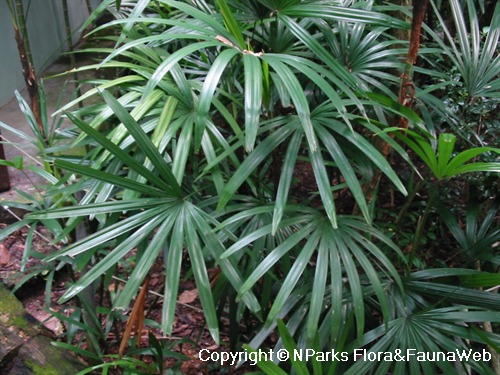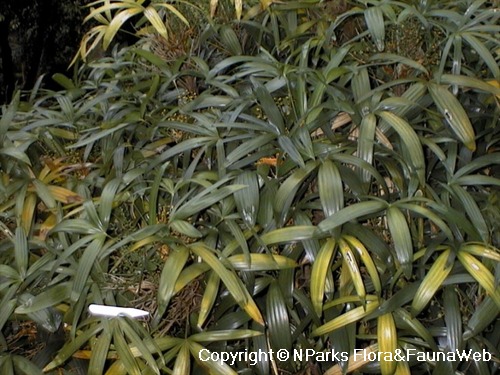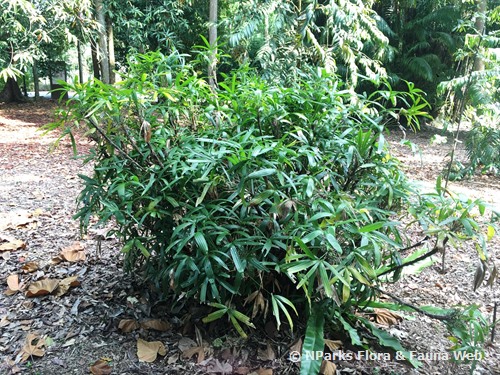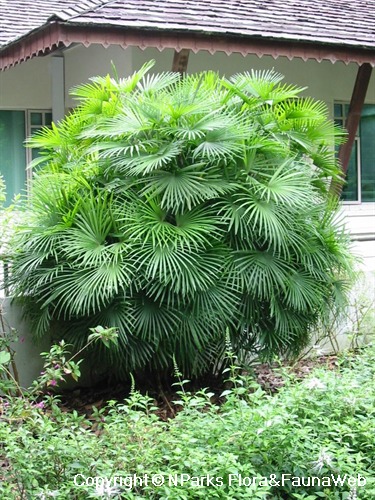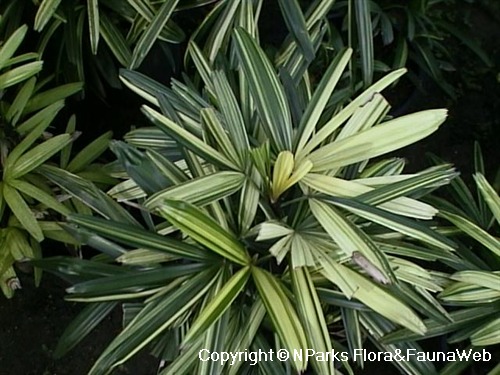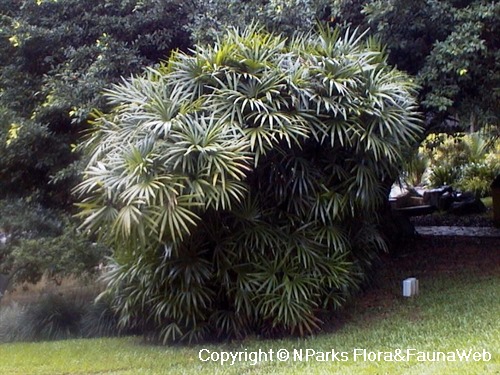
Back
Rhapis excelsa
| Family Name: | Arecaceae (Palmae) |
| Synonyms: | Rhapis flabelliformis |
| Common Name: | Ground Rattan, Bamboo Palm, Lady Palm, Miniature Fan Palm, Fern Rhapis, 棕竹 |
Name
Classifications and Characteristics
| Plant Division | Angiosperms (Flowering Seed Plants) (Monocotyledon) |
|---|---|
| Plant Growth Form | Palm (Clustered Habit) |
| Mode of Nutrition | Autotrophic |
| Maximum Height | 5 m |
Biogeography
| Native Distribution | China |
|---|
Description and Ethnobotany
| Growth Form | A densely-clumping, small to medium-sized palm with attractive, segmented fan leaves persisting down the stems. It produces short spikes of cream flowers among the upper leaves, followed by waxy, white fruits. |
|---|---|
| Trunk | Stems slender, conspicuously ringed with old base leaf scars (similar in appearance to bamboo canes), covered with a coarse, matted, brown-black fibrous material derived from the outer base of the leaf sheathes. |
| Foliage | Fronds palmate, divided into regular, fairly broad (up to 60 cm across), ribbed segments (ranging from 5 to 13 segments), glossy, medium to dark green, leaflets with jagged tips; petioles slender, up to 60 cm long, often covered with greyish hair. |
| Others - Plant Morphology | Flower: Inflorescences relatively short, ascending to spreading, multi-branched, stiff, pinkish, emerging from between leaf sheath and stem (usually arise from te uppermost portion of the stem); flowers spirally-arranged, cream, with 3 petals fused at the base. Fruit: Fruits white, waxy, 1 to 3 seeded, about 0.8 cm long. |
| Cultivation | Though adaptable to a wide range of growth conditions, it prefers moist, neutral to slightly acidic, well-drained soils with organic matter. Best to position plant in a partial shade location with filtered sunlight, and feed with minimal doses of fertilisers. Too much sun and fronds lose its deep green and will become yellowish green, or may even be scorched.Thin out plant and cut away dried or discoloured fronds to improve ventilation and promote growth. Almost disease-free though there may be occasional visits of scales and mealy bugs. Root rots may occur due to poor drainage whilst black fungal spots on fronds can be due to poor cultural practices. Propagate by seeds and divisions. Seeds germinate easily in 6 to 10 weeks. |
| Etymology | Its genus epithet 'Rhapis' derives from the Greek 'rhapis', 'a needle', which is an apparent reference to the leaf segments. Its species epithet 'excelsa' means 'high', 'elevated' or 'tall', an ironic choice of name as it is not the tallest in the genus. Once its prominently ringed stems are revealed by the falling or removal of the fibrous sheathes, they appear quite similar to that of a bamboo, thus one of its common names given, bamboo palm. |
Landscaping Features
| Landscape Uses | Interiorscape/ Indoor Plant |
|---|
Plant Care and Propagation
| Light Preference | Semi-Shade, Full Sun |
|---|---|
| Water Preference | Moderate Water |
| Plant Growth Rate | Moderate |
Foliar
| Mature Foliage Colour(s) | Green |
|---|---|
| Foliar Shape(s) | Palm Fronds (Fan / Costapalmate) |
| Leaf Area Index (LAI) for Green Plot Ratio | 4.0 (Palm - Cluster) |
Non - Foliar and Storage
| Trunk Type (Palm) | Clustering Habit, Aboveground |
|---|
Floral (Angiosperm)
| Flower Colour(s) | Cream / Off-White |
|---|
Fruit, Seed and Spore
| Mature Fruit Colour(s) | White |
|---|
Image Repository
Others
| Master ID | 1383 |
|---|---|
| Species ID | 2676 |
| Flora Disclaimer | The information in this website has been compiled from reliable sources, such as reference works on medicinal plants. It is not a substitute for medical advice or treatment and NParks does not purport to provide any medical advice. Readers should always consult his/her physician before using or consuming a plant for medicinal purposes. |

